Forgotten NY has blazed a trail of urban web photography and commentary for over a decade but sometimes I shudder when I think of the opportunities I missed out on. In 1998 Times Square was a wasteland in transition from the sleazy porn era to the shined up, Disneyfied tourist mecca that it became. They were still actually packing a lot of meat in the Meatpacking, and strolling the streets (that featured two restaurants, Hector’s Cafe and Florent) you caught the delicious and intoxicating whiff of raw cow flesh; and Williamsburg was, well, just about the end of Brooklyn, if not the end of the earth, an industrial afterthought with side streets dotted with 3-story walkups filled with Polish and Czech immigrants. The Poles and the Czechs are still around, but they’ve been totally subsumed by the countercultural – into – mainstream circus/theme park that had descended there beginning in about 2000. I was never able to fully capture these neighborhoods in transition before they transited — since I never knew they were about to transit.
I was able to snatch bits and pieces of these areas before the changes came — I snapped a Dumpster full of bones at Washington and Gansevoort Streets (on my lunch hour working at The World’s Biggest Store), I was able to capture the old Cameo Theatre in its final guise as the Playpen Theatre at 8th Avenue and West 44th; and on a cloudy, cold day in 1998, on a sleepy, deserted Bedford Avenue (which is deserted and sleepy no longer) I snagged an ancient Downer’s Pharmacy awning sign at Bedford and North 4th. The drugstore, which still had an old Ex-Lax laxative ad in one of the windows, later became a bookstore and is now a cheese shop. Perhaps in this walk from South Williamsburg to Bedford-Stuyvesant I might have captured another region in transition — that will look utterly different in ten years, and I can post the pictures and say, “I remember it when…”
I rode the M train for the first time since it switched its route from Queens, into Manhattan, and back to Brooklyn and Queens, taking it from Queens Plaza (no M train had ever previously ventured to the Queens Boulevard line; it’s like your webmaster moving to Cheyenne, WY) and getting out at Hewes Street in South Williamsburg. This station, like Marcy Avenue to the west, allows views of the domed Williamsburg(h) Savings Bank and Williamsburg(h) Bridge, the graffiti on the backs of buildings on South 5th, and new stained glass platform art by Mara Held, El in 16 Notes, installed in 2002.
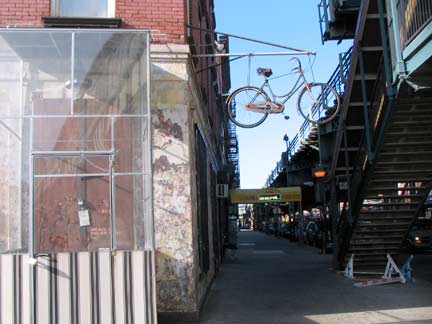
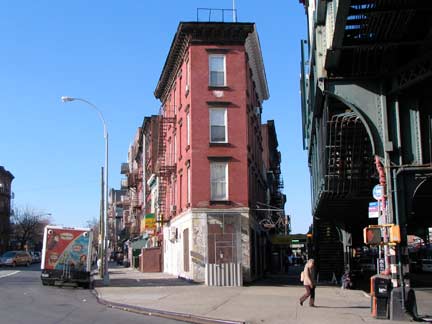
At Broadway and Hewes Street is the eastern extension of Division Avenue, which marks a change in the orientation of cross streets from SW-NE to a more NW to SE direction (all of Williamsburg’s lengthy avenues, Driggs, Bedford, Wythe) change direction at Division Avenue. The intersection of Division Avenue and Broadway makes for an unusual building plot, with an odd-shaped building that inexplicably hangs a bicycle over the sidewalk; perhaps there was once a bike repair shop here. Strictly speaking, Division Avenue marked the line between the village, later city of Williamsburg to the north and Brooklyn to the south. Williamsburg was annexed by Brooklyn in 1855 and gradually, that wedge of streets bordered by Broadway, Kent Avenue (along Wallabout Bay) and Flushing Avenue (formerly the Brooklyn-Newtown Turnpike) became to be thought of as part of Williamsburg; I tend to call it South Williamsburg.
Today those streets are mostly occupied by Latinos and Orthodox and Hasidic Jews — this makes quite a contrast with the north part of Williamsburg, which has become a new NYC entertainment district in the past decade.
 Cross streets in South Williamsburg are named for signers of the Declaration of Independence, with that feature even ‘bleeding’ into Bedford-Stuyvesant south of Flushing Avenue just a little. Hewes Street is named for signer Joseph Hewes (1730-1779) a member of the Continental Congress from North Carolina.
Cross streets in South Williamsburg are named for signers of the Declaration of Independence, with that feature even ‘bleeding’ into Bedford-Stuyvesant south of Flushing Avenue just a little. Hewes Street is named for signer Joseph Hewes (1730-1779) a member of the Continental Congress from North Carolina.
Most signers of the Declaration of Independence have Brooklyn streets named for them, many in South Williamsburg, but others elsewhere in the borough. Stone Avenue (named for Thomas Stone of Maryland) was renamed Mother Gaston Boulevard after Brownsville community activist Rosetta Gaston after here 1981 death, while Paca Avenue (William Paca, Maryland) became Rockaway Avenue and Witherspoon Street (John Witherspoon, New Jersey) became Vernon Avenue.
One of the signers missing in the series, Button Gwinnett (1735-1777) the representative from Georgia. His signature is so rare that it is among the most valuable to collectors in the world; his namesake street here, Gwinnett Street, was renamed Lorimer Street by 1900. Gwinnett perished when he was shot in a duel.
A spectacular painted ad on Hewes Street between Broadway and Harrison Avenue has survived virtually intact from when I first spotted it in 1998, and it had been there for a number of decades before that; it is for “Middlebrooke Lancaster, Inc., manufacturers of Nutrine Beauty Preparations”; this building was likely where it was manufactured. The Nutrine brand is still around — I’m not sure it still operates out of this building. It doesn’t appear that way.
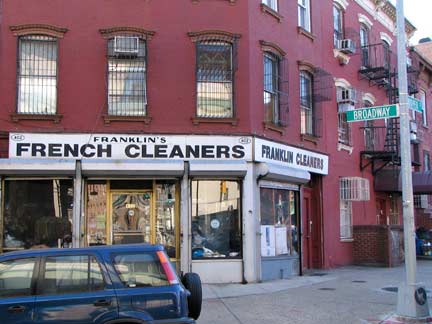
Franklin Cleaners, Broadway and Hooper Street. I liked the simplicity of the black and white signs on both sides of the building.

Name that language, found on a pole at Hewes Street and Harrison Avenue. I’ve found script like this before in the area, but I’m not sure if I got a response the last time I asked about it.
ForgottenFan Larry Berkman: Yiddish
ForgottenFan Stephanie Leveene: First line (reading right to left): getrofn a [last word covered by tape]. In German, “getroffen” is the past tense of “treffen”, to meet. I’m guessing it has the same meaning in Yiddish.
Second line: t’fillin, bitte rofn. T’fillin are small boxes with leather straps on either side. The boxes contain the passage from Deuteronomy about binding the word of God as a sign upon your eyes, or something like that. Orthodox Jewish men bind the t’fillin to their forehead and left arm during morning prayers, using an elaborate series of winds. “Bitte rofn” means “please call [telephone]”, and I see you’ve blocked out the phone number.
ForgottenFan Alex Heppenheimer: The handwritten sign is indeed in Yiddish, and your correspondents have it more-or-less correct. The first line says “getroffen a set,” which means “found a set,” and the second line is “tefillin, bitte rufn” (tefillin, please call). Basically, then, either someone found a set of tefillin (which Stephanie Leveene described well), and wants to return them; or someone lost them, and put up this sign asking if anyone found them.
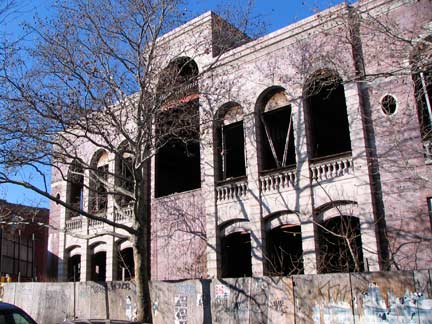
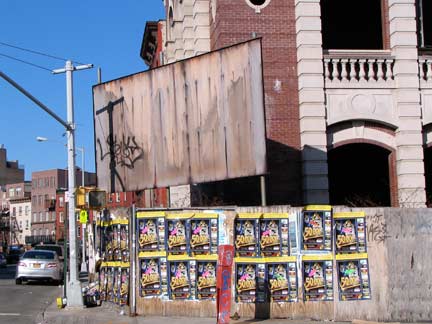
At the corner of Harrison Avenue and Hewes Street is a building that stopped construction so long ago that the signboard advertising what it was going to be is now empty. I struck off down Harrison Avenue, named for Benjamin Harrison — not the 19th Century US President, but his great-grandfather, Benjamin Harrison V, a representative from Virginia.
WAYFARING: SOUTH WILLIAMSBURG to BEDFORD-STUYVESANT
On Harrison Avenue between Rutledge and Heyward stands what used to be the forbidding, monumental PS 122, constructed in 1905, now a school. The building could use an exterior cleaning. Unfortunately after scouring the internet for 20 minutes, that’s the sum total I know about this massive building. Education was a more serious business then for parents and students, and architects built serious edifices dedicated to learning. Do we need more “tiger moms” whose relationship with their children is like that of a drill sergeant to a private? Your webmaster has never come close to having kids, but I’m glad I wasn’t a “tiger mom’s” kid.
So what does the script mean? Is it Hebrew or Yiddish?
ForgottenFan Dave Steckler: [Top line] “Tent (of) Hannah” The word “tent” is sometimes used euphemistically in Hebrew in place of “home” or “house.”
[Second line] The first two letters on the right are an acronym for “built in the name (of)”. [Next word], “The [rabbi’s] wife, the righteous woman [the word is spelled with a feminine suffix], Hannah Teitlebaum, [the last two letters on the far left separated by a quote mark are an acronym for “may the righteous be remembered”].
[Third line] “Daughter of the holy Rabbi Yael Ashekanzi, may the righteous be blessed.”
So:
“Built in the name of the rabbi’s wife, the righteous woman, Hannah Teitelbaum, may the righteous be remembered, daughter of the holy Rabbi Yael Ashkenazi, may the righteous be blessed.”
17th Corps Artillery Armory
The 17th Corps Artillery Armory, originally the 47th Regiment Armory, is one of those handful of NYC buildings that fills and entire block, in this case the one border d by Harrison and Marcy Avenues and Lynch and Heyward Streets. It’s so large it encompasses two separate styles, as we’ll see. As it says on the nameplate above the Marcy Avenue entrance, it was constructed in 1883 (William A. Mundell, architect). The 47th was organized during the Civil War and helped suppress the NYC Draft Riots in 1863.
The 47th Regiment Armory was built at a cost of $125,000 and its original building facing Marcy Avenue ws 200 feet by 204 feet, contained eight company rooms and a drill room, and eight rifle galleries in the basement. This was the only state-sponsored armory built in Kings County during the 1880s, with the others being sponsored by the City of Brooklyn or by Kings County.
As the faded signs indicate the building is currently owned and operated by the National Guard.
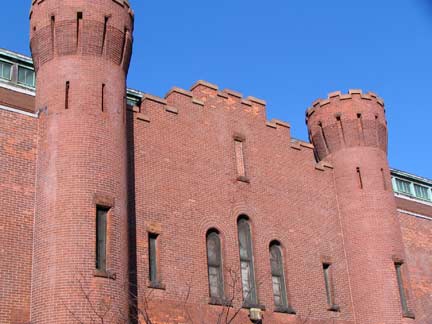
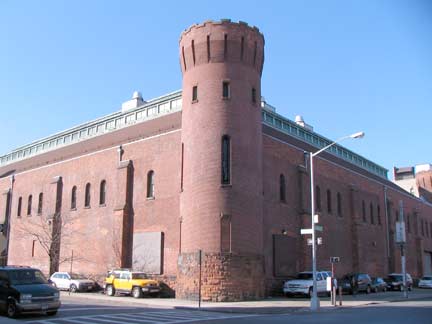
In 1899 the 47th was almost doubled in size by the addition of a huge drill shed (Isaac Perry, architect) with castle-like towers on the Harrison Avenue side — making this side look nothing like the Marcy Avenue side. info from Nancy L. Todd’s New York’s Historic Armories, SUNY Press, 2006
ForgottenFan Edward Findlay: All of the units listed on the two signs are either disbanded or redesignated or moved elsewhere. It is still being used by the Army National Guard and the soldiers are still doing maintenance work except nowadays it is for the aviation and not ordnance corps.
And something to note about the armory — several blockbuster movies have been filmed there including I Am Legend and Sherlock Holmes…
The Union Grounds

The 47th Regiment Armory is built on one of Brooklyn’s most hallowed sites — if you are a baseball fan. Brooklyn’s first professional baseball teams played here for nearly two decades beginning in 1862, including the team that evolved into the Brooklyn, and today’s Los Angeles Dodgers.
Professionalism was made possible by gate receipts from paid admission into enclosed ballparks, which replaced open ball fields so the teams could keep out non-paying fans. Baseball’s first enclosed ballpark was the Union Grounds in Williamsburg, built in 1862 on the blocks surrounded by Harrison Avenue, Rutledge Street, Lynch Street and Marcy Avenue and featuring a three-story pagoda in center field. It was home of the Eckfords and later the New York Mutuals, who were in reality a Brooklyn team when they went professional and eventually became one of the eight founding clubs of the National League. Jealous of the revenues produced by Union Grounds, the Atlantics built baseball’s second ballpark in Bedford two years later, the Capitoline Skating Lake and Base-Ball Ground (early ballparks were flooded in winter for ice-skating), on the blocks surrounded by Halsey Street, Marcy Avenue, Putnam Avenue and Nostrand Avenue. The Atlantics played at Capitoline Grounds until 1879, including the classic game that ended the [Cincinnati] Red Stockings’ winning streak.
No monument or plaque currently marks either site. Old Brooklyn Baseball
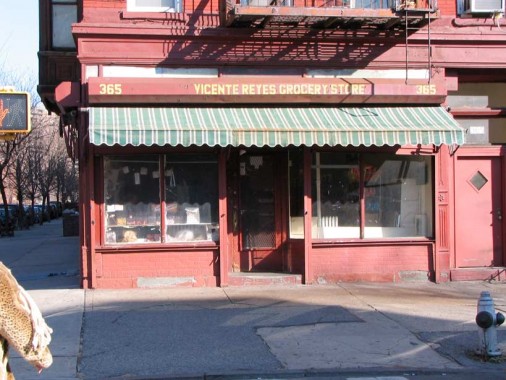
 The corner of Marcy Avenue and Lynch Street has featured a candy store or grocery store for decades. Thomas Lynch, Jr. (1749-1779) was a representative of the Continental Congress, and signer of the Declaration of Independence, from South Carolina. He died at sea at age thirty; his family were Irish immigrants.
The corner of Marcy Avenue and Lynch Street has featured a candy store or grocery store for decades. Thomas Lynch, Jr. (1749-1779) was a representative of the Continental Congress, and signer of the Declaration of Independence, from South Carolina. He died at sea at age thirty; his family were Irish immigrants.
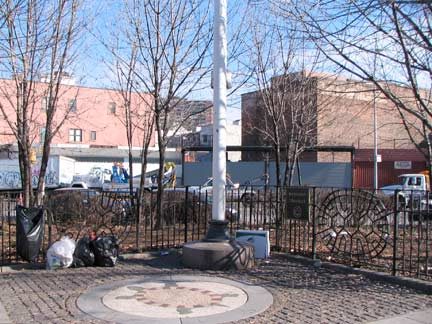
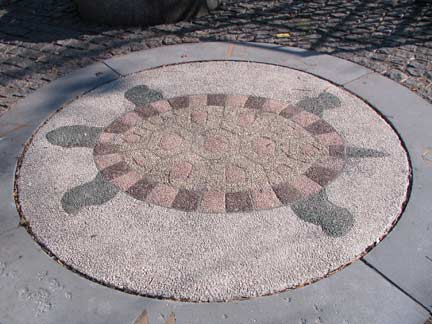
 From armory to Harmony: Union Avenue cuts across the diagonal grid here, creating a triangular plaza at Harrison Avenue and Middleton Street. Formerly called Arlington Square, it was renamed when former Parks Commissioner Henry Stern bestowed it one of his famed portmanteaux: in a somewhat convoluted construction, he took the HAR from Harrison, and the M from Middleton, and got Harmony. Arthur Middleton was a representative from South Carolina when he signed the Declaration of Independence; like Thomas Lynch, he died young, at age 44.
From armory to Harmony: Union Avenue cuts across the diagonal grid here, creating a triangular plaza at Harrison Avenue and Middleton Street. Formerly called Arlington Square, it was renamed when former Parks Commissioner Henry Stern bestowed it one of his famed portmanteaux: in a somewhat convoluted construction, he took the HAR from Harrison, and the M from Middleton, and got Harmony. Arthur Middleton was a representative from South Carolina when he signed the Declaration of Independence; like Thomas Lynch, he died young, at age 44.
Union Avenue in Brooklyn has had an unusual history: it originally ran from Broadway north to Driggs Avenue, originally 5th Street, with a shorter section from Greenpoint Avenue north to Newtown Creek. By the 1890s, the Greenpoint section had been renamed Manhattan Avenue, but when the IND Crosstown Line was extended south and west in 1937, the tracks ran through the thicket of diagonally-oriented streets in South Williamsburg. When the cut and cover procedure was completed, there was a space devoid of buildings, and Union Avenue was extended south from Broadway to Flushing Avenue to run on top of the subway line.
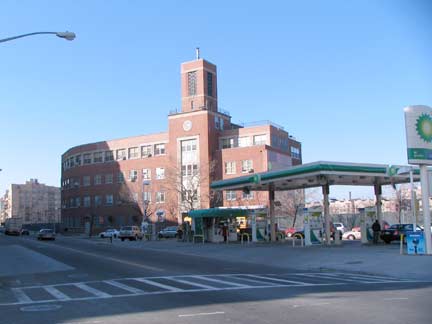
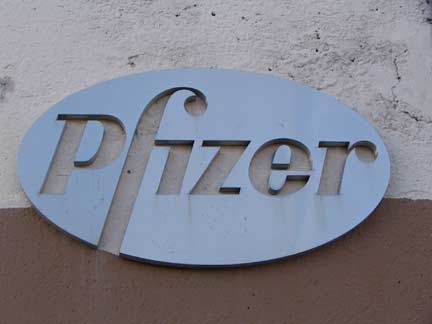
Attaining Flushing Avenue, you can glimpse the former world headquarters of drug and pharmaceutical company Pfizer, Inc. The company originated on Flushing Avenue in 1849 by Charles Pfizer in a building nearby that still stands. Its first product was santonin, a drug originally used to expel roundworms from the system. It moved its main headquarters to Maiden Lane downtown in 1868; it has frequently moved around since and has branches worldwide.
Its production of citric acid in 1880 became its main business for decades; Pfizer pioneered the production of penicilin in 1941. It would become the world’s #1 maker of the new wonder drug during World War II. After severe cost cutting Pfizer was forced to close its Fluahing Avenue complex in 2007, but pledged to convert its original HQ into the Charles Pfizer Community Education Center, which I’m not sure has yet appeared.
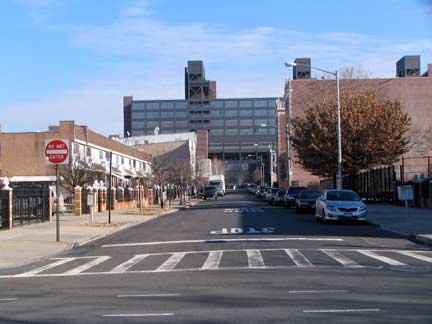
The rather forbidding Woodhull Medical Center at Broadway and Flushing Avenue; it opened in 1982 to replace Greenpoint Hospital.
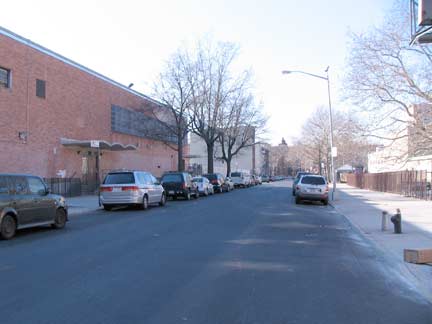
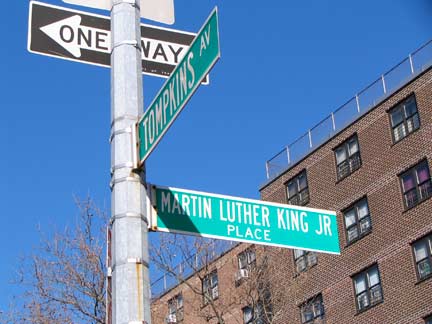
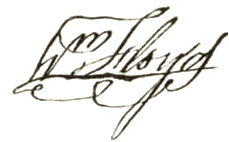 One-block long Martin Luther King, Jr. Place, which runs from Marcy to Tompkins Avenues a block south of Flushing Avenue, might seem inconsequential, but it was the first street in NYC named for the famed civil rights titan, who was murdered on April 4, 1968 in Memphis, TN. It was renamed in 1974. Ironically its old name, Floyd Street, marked the only street in the area named for a signer of the Declaration of Independence from New York, William Floyd (1734-1821). The William Floyd Parkway in his adopted home of Brookhaven in Suffolk County will have to suffice. His descendants include guitarist/singer David Crosby and former Massachusetts Governor William Weld; Abraham Lincoln was a distant cousin.
One-block long Martin Luther King, Jr. Place, which runs from Marcy to Tompkins Avenues a block south of Flushing Avenue, might seem inconsequential, but it was the first street in NYC named for the famed civil rights titan, who was murdered on April 4, 1968 in Memphis, TN. It was renamed in 1974. Ironically its old name, Floyd Street, marked the only street in the area named for a signer of the Declaration of Independence from New York, William Floyd (1734-1821). The William Floyd Parkway in his adopted home of Brookhaven in Suffolk County will have to suffice. His descendants include guitarist/singer David Crosby and former Massachusetts Governor William Weld; Abraham Lincoln was a distant cousin.
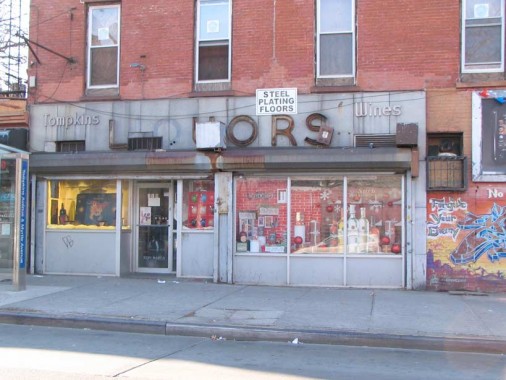
Tompkins Liquors, Tompkins Avenue just south of Myrtle. FNY has visited Tompkinsville, Staten Island, named for US Representative, NYS Governor and two-term Vice President Daniel D. Tompkins. DDT is all over the NYC map as Tompkins Park in Bedford-Stuyvesant and Tompkins Square Park are also named for him. It is perhaps serendipitous that a liquor store also bears his name, since a charge that he illegally profited from the War of 1812 haunted him for years and led to his downfall by alcoholism.
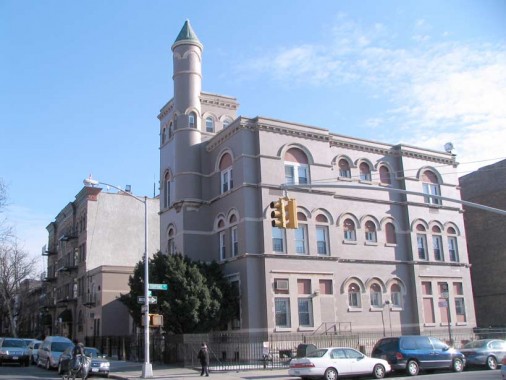
I’m afraid I know nothing at all about this magnificent towered building at Tompkins and Vernon Avenues. I call it the Vernon Castle, which has nothing to do with the famed British ballroom dancer (1887-1918). Can anyone fill me in?
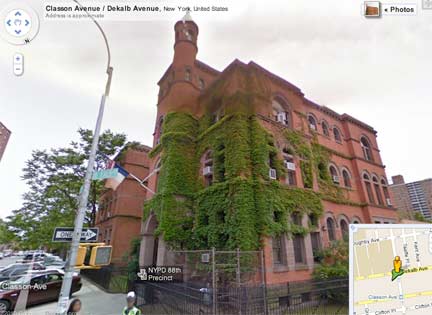
Another mystery: it’s a near carbon copy of the NYPD 88th Precinct house at Classon and DeKalb Avenues.
The buildings were designed as precincts by the same architect and were built around 1889-90. The current 88th started as Brooklyn’s 4th Precinct and then became the NYPD’s 56th before becoming the 88th in 1929. Old Traffic F (Vernon and Tompkins) started as Brooklyn’s 13th Precinct and then became the NYPD’s 58th before becoming a Traffic precinct in 1922. PoliceNY
I’m fascinated with DeKalb Avenue, from first encountering it in downtown Brooklyn as a kid, riding past it on the way to the now-demised (or Macyized) A & S with the folks in the now-demised B37 bus that used to go down 3rd Avenue. I’d ride it first past the now-demised Albee Theatre at DeKalb and Fulton, and later, I’d ride it past the now-demised Albee Square Mall. Well, the timeless and eternal Dime Savings Bank at Albee Square is still there. DeKalb also rates two seperate BMT subway stops in two separate parts of Brooklyn: downtown and Ridgewood.
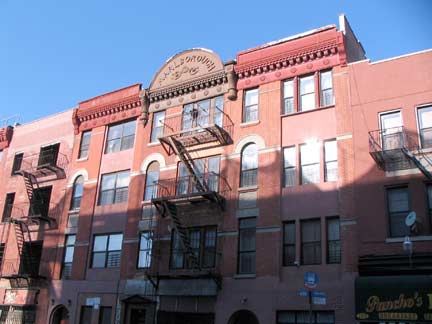
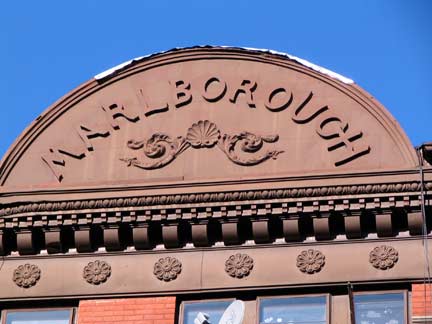
On DeKalb off Tompkins in Bedford-Stuyvesant I noticed the Marlborough Apartments, especially the nameplate on the pediment, which is lettered in a curvy sanserif style used in the 1890-1900 period.
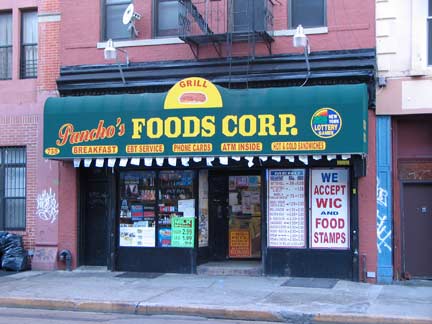
I usually don’t like modern vinyl awning signs, but this one, for Pancho’s Foods, boasts terrific block lettering and basic red, yellow and green coloring.
Meet me at Mt. Pisgah
The massive Mount Pisgah Church dominates the west side of Tompkins Avenue between DeKalb Avenue and Kosciuszko Street. The church, and the brick building on the right, were formerly St. Ambrose Catholic Church and School, with the church, awash in terra cotta detail, constructed in 1883, the school 1911. The Catholic church and school closed in 1978, merging with Our Lady of Monserrate on nearby Vernon Avenue. The present occupant, Mount Pisgah Baptist Church, was founded by Rev. Salina Perry in 1931 and the church acquired this building after St. Ambrose moved out. The building’s Catholic legacy, however, can be readily seen in the colorful and ornate terra cotta detailing. In the Book of Deuteronomy, Mount Pisgah was the location where Moses saw the Promised Land after decades of wandering in the wilderness with the Israelites; for previously doubting God, however, he was not allowed to enter it.
1/23/11


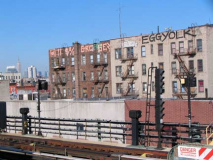
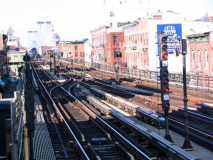
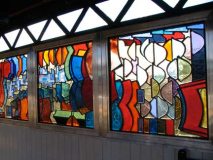
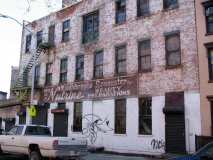

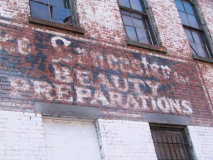
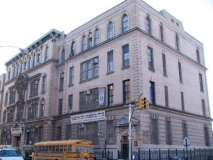
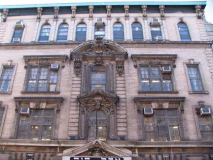
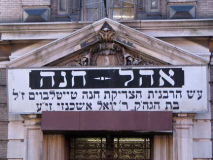
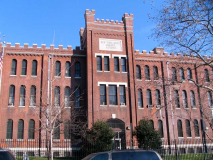
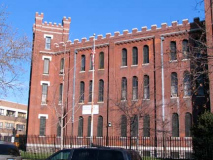
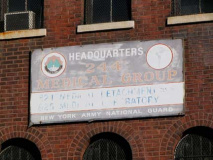
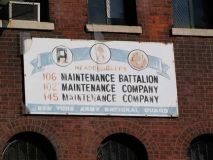
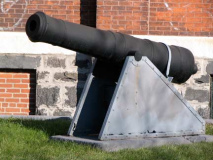
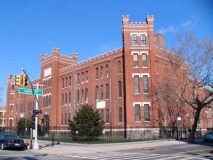
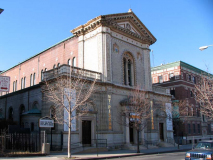
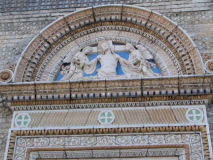
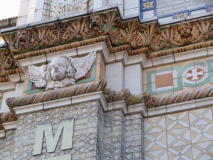
37 comments
The place with the old bicycle as its sign is a restaurant called Moto. Great place with live music nightly.
When Martin Luther King Jr. Place was still Floyd Street, there was a very old elementary school, P. S. 55 located there. I lived in Marcy Housing Projects in the mid 1950’s and went to PS. 55 from Kindergarten to 3rd grade. I haven’t been able to find out anything about it other than an old article in the Brooklyn Eagle newspaper archives, indicating that an addition was added to it around 1900. I believe the school itself was built in 1887. Is it possible to locate any old photos of the school or at least to learn when it was demolished?
I WENT TO PS55 AT THE SAME TIME, MRS WELKAM, MISS KEENE ,MR SAFFNER, I WORKED AT JOES DELIE ON MARCY AVE WE MUST HAVE SOME SORT OF CONNECTION IM 74 YRS OLD. I LIVED ON FLOYD ST #115. I WAS A SINGER WITH THE FLOYD ST. BOYS, DO YOU REMBER THE LIQUER STORE ON CORNER OF MARCY & FLOYD ST ALSO ASSOSIATED FOOD STORE SAME CORNER? CASCADE LAUNDRY? EMBEGNER BACKERY I REMBER WHEN THE PROJECTS WENT UP DO YOU KNOW CHARLES WALTERS OR MILLIE NEVIES FROM THE PROJECTS? CONTACT ME @ MRSUNSHINE2525@ATT.NET OR CALL ME @ 407-365-6020 thanks know the folling? SHO SHO, RICHIE ROSE, CURRENTIE BROTHERS, KATHY FORD,COOKIE GUZZMMAN, FRANK TRAMA, PS148 ON ELLERY ST?
Hello. I just read your post. I went to ps 55. I lived at 258 floyd st. My mom worked for cascade laundry. I remember the old neighborhood well. Some names i remember. Molly h and josephine c. Catherine. C
It’s been quite sometime since you posted. I’m in the middle of creating a special scrapbook album for my mom – Adriana Gonzalez (born 1940). She grew up on Floyd St # 180 from about 1950 until she married my dad (Joseph Soto) in 1958. It seems by 1950 four siblings all lived on Floyd St. My maternal grandparents – Josephine & Otoniel Gonzalez with 2 daughters Adriana and Estrellita (born 1948) – #180; Josephine’s sister – Ana & Jose Sanabria with their two boys, Jose (born 1935) & Anthony (born 1945) – #175; and sister – Felicita & Agusto Rodriguez with their daughter Dora (born 1927) – #177; and a brother – Domingo & Aurelia (we called her Lily) with their two kids, Lillian (born 1935) and Robert (born 1933) – #195. Anyway, my mom is now 84 yrs old and I am constantly asking her questions about what it was like growing up. She loves to tell stories and has a great memory about relatives I both knew and never heard of. She did say she attended PS 55 on Floyd St, then I.S. 33 Mark Hopkins Junior High School (I have a class photo dated 1955); and finally Eastern District High School.
I lived in the March Housing projects from just after they were completed until about 1957-58. I went to PS 55 untile 3rd grade. I had Mrs. Laskowitz, Ms. Hollman (sp?),and Mrs. Andersen. I was then sent to Ps. 16 on Lee Avenue where I finished 6th grade. I remember the Cascade Laundry but not much else. I do remember that PS 55 was very old, very big and ornate (lots of ironwork). I was afraid of it when I first started going to school.
Hello, old friends! I went to P.S. 55 for first and second grades, Mrs. Johnson both years, from 1952 to 1954.
I lived on Vernon Avenue between Marcy and Tompkins Avenues.
My paternal grandma and grandpa lived next door, and a great-aunt lived on Ellery Street.
I do remember the old Floyd Street school very well (as well as might be expected for a youngster, anyway).
(I am now retired and living near the Pacific Ocean in California: quite a change of scenery!)
Very best wishes to one and all.
M J R
I’m currently working on making a special scrapbook for my mom who lived on Floyd street from some time after she was born in 1940 (definitely in 1950 confirmed by the 1950 US census) until she got married to my dad in 1958. During my extensive research I did find a photo of PS 55 on Floyd St circa 1931 on the NYPL Digital Collection website. Since I can’t attach the actual photo here is the link… https://digitalcollections.nypl.org/items/510d47dc-cf46-a3d9-e040-e00a18064a99#/?uuid=510d47dc-cf46-a3d9-e040-e00a18064a99
I lived on Myrtle Ave. btn. Tompkins & Marcy. I attended PS55 on Stockton (sp?) St. from 1927 to approx . 1932 then went toJHS 148 (John Hopkins) on Ellery St.. and from there to Boys High on Marcy Ave. The Cascade laundry was at the corner of Myrtle & Marcy, all three of my sisters worked there at one time or another in the Depression. Toward the corner of Tompkins on Myrtle stood Muellers, an ice cream parlor non pareille, what was called the German Bakery around the corner on Marcy emanated the most heavenly fragrances in the evening as you descended the cellar steps to buy delicious buns hot from the coal fired oven. There are so many memories too many to write about here I suppose . I hope there is someone out there who might have been a contemporary & will reply. Anyone from PS55?
My sister Pricilla(Pat) always took me To Muellers on Myrtle Ave. She attended 148 about the same time you did.
My mom worked cascade laundry during 1950 etc. I went to ps 55 and then to jr 148. I lived at 258 floyd st
I Lived on Stockton St between Marcy and Tompkins and went to P.S. 55 and JHS 148
I lived right across the street from the castle building on Vernon and Tompkins from 1956 to 1974. The building was a police station when I was small and we spent lots of time watching the boys play stick ball with the police officers.
The building was indeed a police station. It was “Traffic K”. I lived on the block from 1942 till 1955. Went to Ps 55 and JHS 148.
Lots of the photos are of places that bring many fond memories of my childhood. St. Ambrose, Monseratte, Police Station, stores, etc.
Great pictures!
I remember st. Ambrose well. Have very fond memories
Does anyone know where i can find photos of old floyd street in 1950. St Ambrose catholic school. Ps 55. I lived at 215 floyd st. I remember some friends. Molly herman. CAtherine chambers. Josephine caniano
I went to ps 55 in 1949 0r 1950. I remember 2 teAchers. Mr winston. History and Mrs english. Very fond memories
I lived on Vernon between Tompkins and Throop from1943 until 1955. The big building on the corner was a police station Traffic K. I went to PS 55 from kindergarten until 6th grade, and then to Mark Hopkins Jr. High. Some teachers in 55 were Mrs. Keene, Mrs. Sunstrom, Mrs. Larsen, Mrs. Weltman, Mr. Fasner.
I went to ps55 from 1950 to 1956 when it closed and then were transferred to ps 33 on throop ave I remember mrs Welcome and Mrs Samuels
We went to ps 55 in 1950’s Rose and my brother Sal DePaola. We remember Mrs. Weltman, Mr. Fishman. Went to school with the Resto family and Andino or Endino family? And new the Pisano family. They owned the funeral parlor on Park Ave and Tompkins.
I lived in the Marcy projects from January 1948 to 1961 I attended PS168 then Jr High school 148 I also went to All Saints Church on Throop Ave My dad worked in Pfizer Wonderful memories.
I was born and raised in the area. Lived on Middleton, went to PS 122, and IS 71 both across the street from the Armory. Wonderful memories!!!
Mike FC
I was born and raised in the area, I attended PS 122, and IS 71 across the street from the Armory wonderful memories!
Walked the street many many times wow to see this pictures.
Mike
High Miguel, I was born and raised in the area also. Attended PS 122 for eight yrs from kindergarten to 8th grade. Thought I got a terrific education.
Are you old enough to remember the horse stable between Rutledge and Broadway? I dob’t remember IS 71. When I graduated I went to Eastern District High School on Marcy Ave.
I went to PS 122 then Easter District HS. Graduated 122 in 1958 then went to ED. Lived on Lee Ave.
The horse stable was ON Rutledge Street, between Harrison Avenue and Broadway, a stone’s throw from the Good Humor garage. I lived on Marcy Avenue, 2 doors from the corner of Lynch Street, on the side of the
armory. In my late teens, moved to Rutledge Street, right off Marcy Avenue. The other end of the street was Harrison Avenue.
Attended PS 122 from Kindergarten thru 8th grade. Was graduated in June, 1953 and then went to Eastern District until June, 1957.
I lived in the Marcy Projects in the 50″s. I attended P.S. 55 on Floyd St and then attended Mark Hopkins JHS 148 on Ellery St. I then went to Boys High Annex and later switched to the main building. I moved to Bensonhurst and attended Lafayette H.S. Among the graduates of Lafayette were Peter Max (Finkelstein), Larry King, Sandy Kofax, etc. My mother worked for Pfizer on Flushing Avenue. Fond memories.
Hello Ellis, I lived at 133 Ellery from 1947 to 1949. My family moved to 910 Myrtle Ave and Tompkins. Yes, we attended the attended
PS 55, JHS 148 and JH S 33 . However I went to Eastern District HIgh School I went onto NYC community and Burach College. My family and I left New York in 1980 and lived in Metro Atlanta for 35 years. Now retired in sunny Central Flirida.
Antonio Tony Flores.
My dad’s family lived at 257 Floyd St. in the 20’s, 30’s and 40’s. Anyone remember Kaplowitz family?
I lived on Pulaski Street on or about the early 60’s. I remember St Ambrose. Does anyone remember The Burger Flame? Best Burgers ever!
I attended st Ambrose from 1949-1957 sr. St Hugh I lived at 118 Pulaski st between Tompkins and Marcy. Then mov now live in st pete bch fl
I lived at 118 Pulaski st. I attended st Ambrose from around 1949 to 1957 . Then went to bushwick high and eastern district. Then moved to queens village lemony , north woodmere coram .now widowed in st pete bch, fl
I lived at 118 Pulaski st between Thompkins and Marcy. I attended st Ambrose from apex 1949 to 1957. Sr. St Hugh was the meanest nun. My best friend was Myrna Guadalupe a d sal vitellaro. I then moved to queens village, I am now widowed, and live in st pete bch, Florida
I grew up in williamsburgh,went to transfiguration school on hooper street and high school at Chelsea vocational in manhattan,great are to grow up.
Robert Zoeller
I think you and your parents were tenants at 248 Penn St my parents brownstone… Is that right?
To: Robert Zoeller – Did you have an older sister, Margaret Ann? Did your grandmother live on Marcy Avenue near Lynch Street?
To: Russell Kruckman: If I recall correctly your mom used to teach either at 122 or Eastern District. Was her name Selma? I think you were friends with my brother, Ronny.